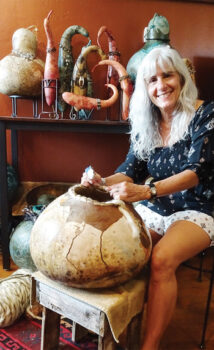 LaVerne Kyriss
LaVerne Kyriss
Jayne Colburn attributes the inspiration that results in a finished piece to nature and her maternal grandparents. “My great-grandmother and grandmother, as well as my grandfather, were basket makers,” she explains, showing off a few of the baskets they made, which she has lovingly displayed in her light-filled casita studio.
“I met a basket maker in 1985. She taught me to weave pine needle baskets,” she said. “Then one day I saw a gourd at a farmer’s market and decided to see if I could do something with it. Creating unique art pieces from gourds and basketwork just took off from there.”
Colburn sources many of her gourds from the Wuertz Gourd Farm in Casa Grande and notes that she was one of their first commercial customers. “I met Waylon at a Midwest craft fair where I was displaying my art. We started talking about what artists needed in a gourd, because he was considering branching out to grow gourds for artists. I’ve been buying gourds from him ever since.”
Colburn says that creating a gourd vessel is a labor of love. “Each piece is a unique creation with its own personality and character. It’s almost like giving birth to a child. I photograph and number each one.” With more than 7,000 gourd vessels completed to date, Colburn has refined her technique and approach.
It’s a long, involved process to go from a raw gourd to a finished piece, she explained. “First, I go to the field to pick out gourds. These days, I’m drawn to larger gourds, because it’s easier on my hands to do the woven elements.”
After hauling a load of promising gourds home, Colburn lets them sit in her garage for a while to dry out. “These are organic products that, when harvested, are still quite full of water, and you can’t begin to work on them until they are quite dry.”
Then the cleaning process begins. “You have to scrub off the dirt and kill any mold that might be lingering,” she said. “While I do this work, I’m beginning to get to know each individual and learning to understand what they want to be when they grow up,” she smiled. Colburn draws where she’ll cut an opening and clean out the insides. Then it’s more drying time before she drills holes to attach the woven work and begins the process of adding pigments in multiple layers. Next, the vessel’s exterior is sealed to preserve it. She then selects various fibers or pine straw to weave a collar. “I also often add embellishments, including jewelry, and select a stand for the finished piece. I’m always on the lookout for unique items to add to my pieces.”
Colburn encourages people to get out of their own way and try something creative. “Find out what fills you with passion. If you try something and it doesn’t sing to your soul, try something different. If you love something by another artist, but that’s not your gift, buy the piece from them. God gave you talents, and you can be fulfilled by using your gifts,” she said.
To learn more about the artists who make up the SaddleBrooke Fine Arts Guild or explore classes and other guild activities and events, visit them online at saddlebrookefinearts.org.
